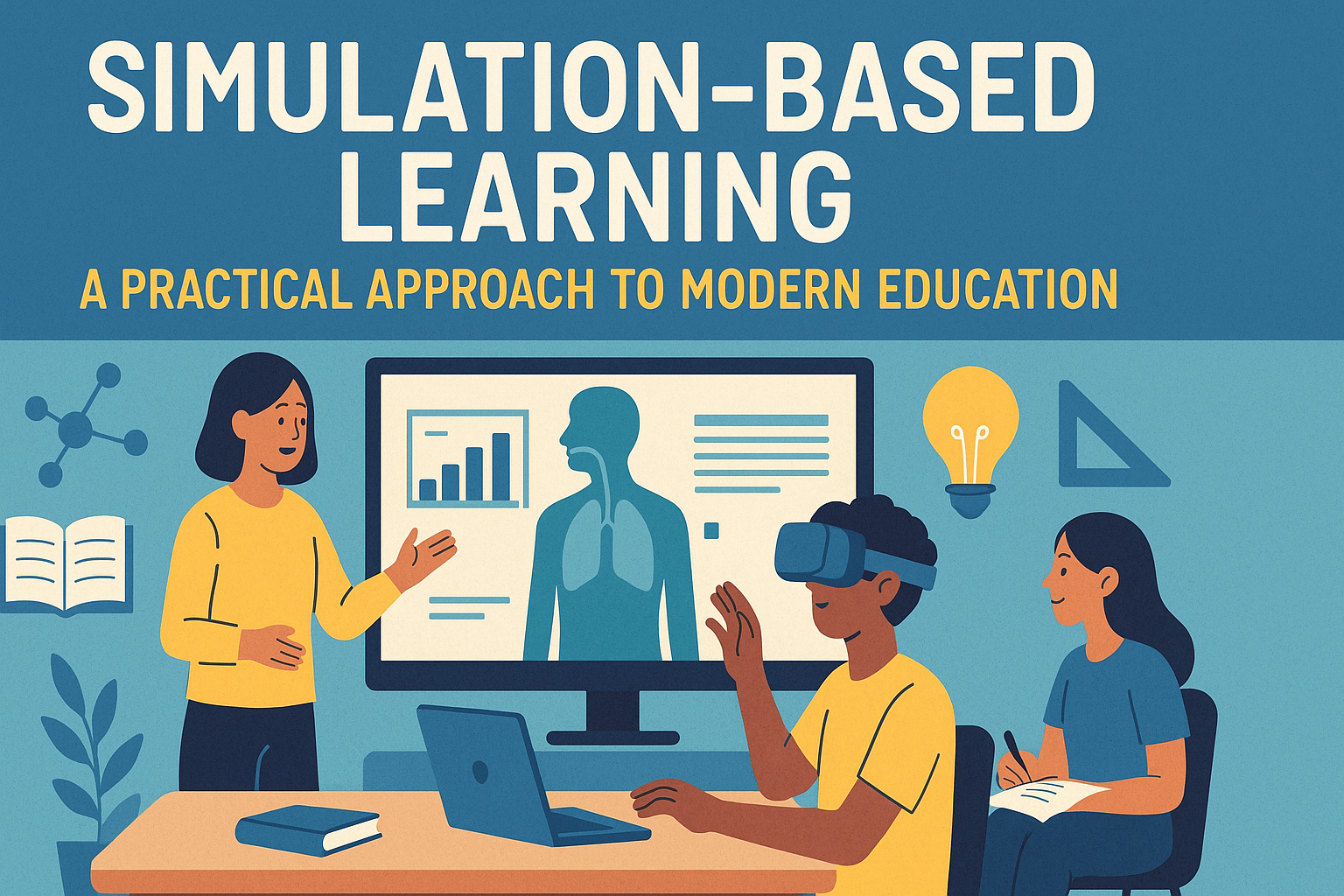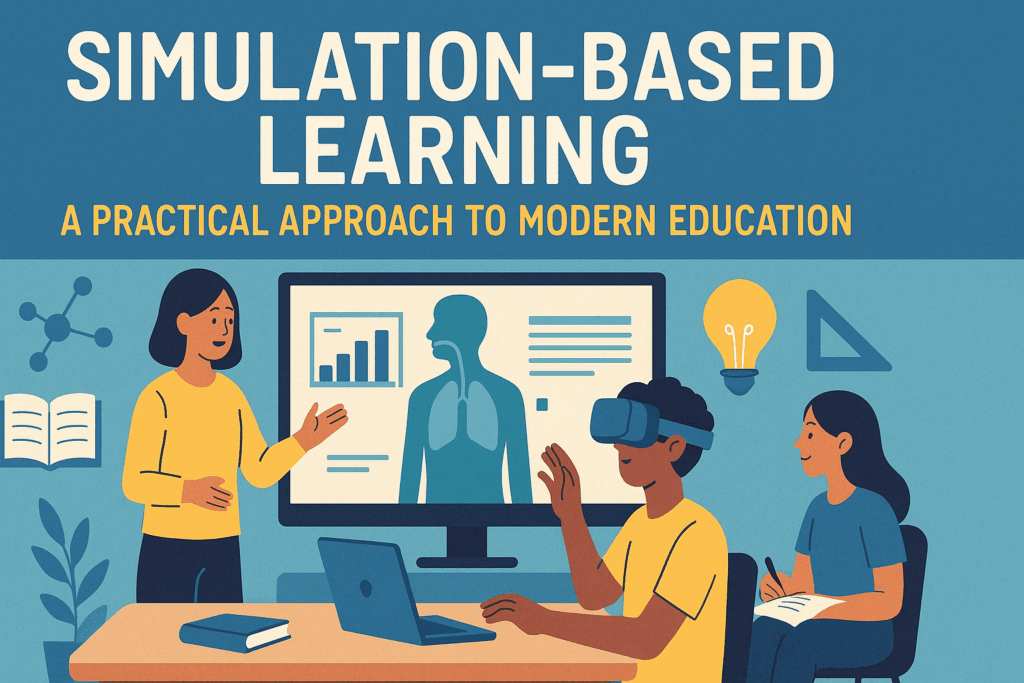Simulation-Based Learning: A Practical Approach to Modern Education

Simulation-based learning has become a popular tool in education. This method uses virtual or physical models to recreate real-world situations. It helps students practice skills and solve problems without real-world risks. It’s effective in fields like healthcare, aviation, business, and engineering. In this post, we’ll explore what simulation-based learning is, its benefits, and how it is changing the way we learn.
What Does Simulation-Based Learning Look Like?
Simulation-based learning involves creating realistic scenarios that mimic real-life situations. These can be computer programs or physical models. Learners interact with these setups, solving problems or making decisions as if they were in the actual situation. It gives them a hands-on experience while staying in a safe environment.
Examples of Simulations:
-
Virtual environments: Online simulations for business or engineering tasks.
-
Physical models: Like flight simulators or medical mannequins for practicing surgery.
The key is to allow learners to experience situations they would normally face in their field.
Benefits of Simulation-Based Learning
This type of learning has many advantages. It changes the way we approach education by making it more interactive and practical. Here are the top benefits:
1. Realistic Practice Without the Risk
Students can practice without worrying about real-world consequences. For example, pilots can train in flight simulators without any danger. Doctors can perform surgeries on mannequins instead of real patients.
2. Builds Confidence
Simulation allows learners to try tasks repeatedly. This practice helps them build confidence. The more they practice, the more comfortable they become.
3. Immediate Feedback
Simulations provide instant feedback on performance. If something goes wrong, the learner can adjust and try again. This feedback is crucial for improvement.
4. Safe Environment for Mistakes
One of the best parts of simulations is the ability to make mistakes safely. Students can learn from their errors without facing the real-world consequences. This helps them improve without feeling discouraged.
5. Cost and Time Efficient
Training through simulations is often cheaper than traditional methods. For example, flight simulators are more affordable than flying real planes. Plus, learners can repeat simulations as many times as needed.
How Simulation-Based Learning Works
Here’s a simple step-by-step breakdown of how simulation-based learning usually works:
Step 1: Define the Learning Goal
Before creating a simulation, it’s important to know what the learner should achieve. This could be learning a new skill, solving a problem, or practicing a technique.
Step 2: Develop the Simulation
The simulation is then created based on the learning goals. It may include scenarios learners could face in real life, like managing a business crisis or performing an emergency surgery.
Step 3: Let the Learner Engage
Learners interact with the simulation. They solve problems, make decisions, and see how their actions play out. This process mirrors real-world experience.
Step 4: Offer Feedback
After the simulation, learners receive feedback on what went well and what could be improved. This is where the real learning happens.
Step 5: Repeat and Master
Learners often go through the simulation multiple times. Each time they improve their skills and become more confident.
Real-World Applications of Simulation-Based Learning
Simulation-based learning is used in many different industries. It’s a powerful tool that allows people to practice before entering high-stakes environments.
1. Healthcare and Medicine
In healthcare, simulations allow medical students to practice surgeries or diagnose patients without the risk of harming someone. They can learn how to react in emergencies and improve their skills over time.
2. Aviation
Pilots have been using flight simulators for years. These machines replicate the experience of flying an airplane, helping pilots practice maneuvers, navigation, and emergency situations in a controlled environment.
3. Business
Business schools use simulations to teach students how to run companies. Learners can make decisions about marketing, finance, and management. They see the outcomes of their choices in real time.
4. Engineering
Engineering students can use simulations to test designs and ideas without building costly prototypes. It’s a way to experiment and see if an idea works before investing resources into it.
5. Military and Defense
The military uses simulations for combat training. Soldiers can practice tactical skills, decision-making, and teamwork in virtual environments.
Advantages of Simulation-Based Learning Over Traditional Methods
 Simulation-based learning offers several benefits over traditional teaching methods:
Simulation-based learning offers several benefits over traditional teaching methods:
1. More Hands-On Learning
In traditional classrooms, learners may only read or watch videos. Simulations let them interact with the material and practice skills actively. This is much more engaging.
2. Realistic Experience
Students experience real-world situations without the risks. For example, doctors can practice complicated surgeries in simulations before working with real patients.
3. Better Retention
Research shows that learners retain information better when they are actively involved. Simulations require learners to solve problems, which helps improve long-term memory.
4. Customizable Learning
Simulations can be adjusted to meet the needs of different learners. The difficulty level can be increased or decreased based on their progress.
Read More » Private Company Job Vacancies: A Simple Guide to Finding Work
Challenges of Simulation-Based Learning
Though simulation-based learning has many benefits, there are some challenges:
1. Cost of Development
Creating high-quality simulations can be expensive. This is especially true for industries that require highly detailed models, such as healthcare or aviation.
2. Technological Limitations
Some simulations may not fully replicate real-world conditions. This can limit their effectiveness. The technology used in simulations is constantly improving, but it’s still a work in progress.
3. Requires Proper Training
Learners need to understand how to use simulations. Without proper training, they may not get the most out of the experience. It’s important for instructors to guide students through the process.
Conclusion: The Future of Simulation-Based Learning
Simulation-based learning is changing the way we approach education. It offers a hands-on, realistic way to practice skills in a safe, low-risk environment. As technology improves, simulations will continue to play a bigger role in training across many industries. From healthcare to business, this method is an effective way to prepare learners for real-world challenges.
As it becomes more affordable and accessible, we expect even more industries to adopt simulation-based learning. The future of education is here, and it’s interactive, immersive, and practical.
FAQ
1. What is simulation-based learning?
Simulation-based learning is a teaching method that uses virtual or physical models to recreate real-life scenarios. It allows learners to practice skills in a safe, controlled environment.
2. What are the benefits of using simulation-based learning?
Simulation-based learning offers many benefits, including a realistic practice environment, safe learning from mistakes, instant feedback, and increased confidence.
3. Which industries use simulation-based learning?
Industries like healthcare, aviation, business, engineering, and the military use simulation-based learning to train and prepare learners.
4. How does simulation-based learning differ from traditional education?
Unlike traditional education, which often relies on textbooks and lectures, simulation-based learning lets learners actively engage with realistic scenarios. This leads to better retention and skill development.
5. Are simulations expensive to create?
Yes, creating detailed simulations can be costly, especially for fields like healthcare and aviation. However, the long-term benefits, such as reduced risk and better training outcomes, make it worthwhile.
Read more: T Mobile Insurance: Everything You Need to Know Before You Enroll
| Industry | Simulation Tools Used | Applications |
|---|---|---|
| Healthcare | Medical mannequins, virtual surgeries | Surgery practice, diagnosis training |
| Aviation | Flight simulators | Pilot training, emergency procedure practice |
| Business | Virtual business simulations | Business management, financial decisions |
| Engineering | Design software, testing simulations | Product design, system testing |
| Military | Combat simulators, strategic exercises | Combat training, mission planning |

